
This atlas of microfractographs—fracture images seen under a
microscope, includes both profile and surface views of the specimens, and comprises a systematic documentation of aluminumsilicon alloys with relevant descriptions. The challenges of fractography are discussed in a comprehensive manner. The atlas
contains images of fractures obtained during laboratory testing of
mechanical properties. A set of images covers hypoeutectic, eutectic, and hypereutectic (mainly permanent mold) cast aluminumsilicon alloys. The surface of fractures visible under highresolution scanning electron microscopy (SEM) are shown together
with subsurface effects on metallographic specimens normal to the
fracture plane, observed with light microscopy.
This book also deals with the physical, crystallographic, and
microstructural aspects of the formation of aluminum-silicon cast
alloys as they relate to mechanical properties. The criteria of fracture classification are established along with a set of the most
important data on the morphology of the basic types of fractures
that occur in metals used in structures. These may be used as a basis
in the classification of fractures and in an assessment of the fracture
path, its mechanism, and conclusions on the possible causes of a
failure.
The alloys presented in this atlas are commercially important as
their high strength-to-weight ratios make them suited for applications where reduction of weight is a design consideration, such as
in automobile engine blocks, gear boxes, aerospace castings, and
consumer products, as well as in marine and architectural uses.
This book is an English version of the atlas that was published
in Poland in 2000. The author wishes to acknowledge her teacher
Professor Stanisław Gorczyca, one of the pioneers of electron
microscopy in Poland, to whom she is indebted for helping her
finding a place in the world of technology. The author wishes to
thank George Vander Voort, FASM, who brought this work to the
attention of ASM International and Dr. Jerzy Tybulczuk (Foundry
Research Institute) for support in the conception of this book.
دیدگاه خود را ثبت کنید